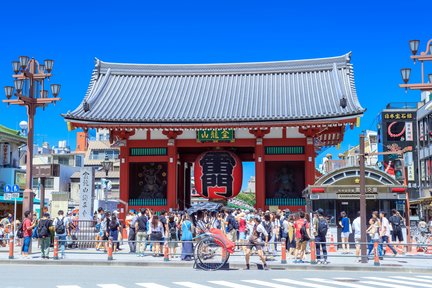Sensoji Temple
The best of Sensoji Temple
Bucket-list experiences
Make it a getaway
Trouble-free transport
All that's good & tasty
More to explore
Why people love Sensoji Temple
Nearby places to go
FAQs about Sensoji Temple
What are the best times to visit Sensoji Temple?
What transportation options are available to reach Sensoji Temple?
What important travel advice should I know when visiting Sensoji Temple?
What to know before visiting Sensoji Temple
Remarkable Landmarks and Must-Visit Sights
Kaminarimon Gate
The imposing Kaminarimon Gate, also known as the Thunder Gate, welcomes visitors to Sensoji Temple. Adorned with a massive red-and-black paper lantern, this iconic Buddhist structure sets the tone for the temple visit.
Nakamise-dōri Street
Explore Nakamise-dōri Street, lined with traditional shops selling a variety of goods, from hand-made noodles and sushi to traditional sweets and souvenirs. This bustling street leads visitors to the temple, offering a glimpse into the local culture.
Hōzōmon Gate
Pass through the Hōzōmon Gate, the Treasure-House Gate, to enter the inner complex of Sensoji Temple. This two-story gate houses many of the temple's treasures and features guardian statues, lanterns, and large sandals.
Culture and History
Sensoji Temple, founded in 645 AD, holds deep cultural and historical significance as Tokyo's oldest temple. Discover the origins of Sensoji Temple, dating back to 628 when fishermen found a statue of Avalokitesvara Bodhisattva. Learn about the temple's growth during the Kamakura and Edo periods, becoming a cultural hub in Edo city. Destroyed during World War II, the temple was rebuilt as a symbol of rebirth and peace. The temple complex includes a quiet contemplative garden and traditional rituals like o-mikuji stalls.
Local Cuisine
Experience the flavors of Tokyo with traditional dishes available in the surrounding area of Sensoji Temple. Indulge in popular local dishes near Sensoji Temple, experiencing unique flavors and must-try foods that reflect the culinary heritage of the region. From hand-made noodles to tempura, visitors can enjoy a variety of local cuisine while exploring the temple and its vibrant surroundings.

![[Classic Tokyo Day Tour] Meiji Jingu Shrine + Harajuku + Shibuya](https://res.klook.com/image/upload/fl_lossy.progressive,w_432,h_288,c_fill,q_85/activities/vqdxqvpdfrb0s18sbqio.jpg)


